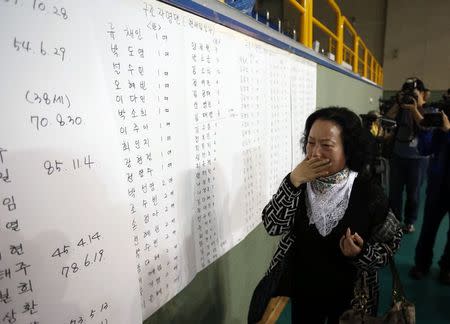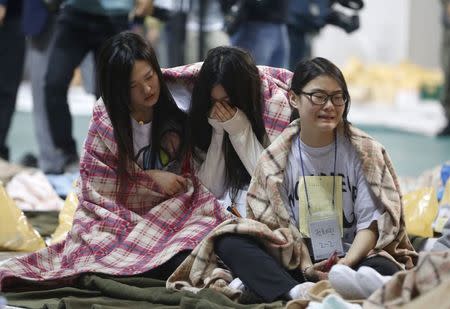Over 280 missing after South Korean ferry capsizes
By Narae Kim JINDO South Korea (Reuters) - More than 280 people, many of them students from the same high school, were missing after a ferry capsized off South Korea on Wednesday, in what could be the country's biggest maritime disaster in over 20 years. The ferry was carrying 462 people, of whom 174 have been rescued, coastguard officials said. Four people were confirmed dead, but as frantic rescue operations continued late into the night under light from flares, hopes were fading for the 284 unaccounted for. It was not immediately clear why the Sewol ferry listed heavily on to its side and capsized in apparently calm conditions off South Korea's southwest coast, but some survivors spoke of a loud noise prior to the disaster. "It was fine. Then the ship went 'boom' and there was a noise of cargo falling," said Cha Eun-ok, who was on the deck of the ferry taking photographs at the time. "The on-board announcement told people to stay put ... people who stayed are trapped," she said in Jindo, the nearest town to the scene of the accident. The families of those still missing faced agonising uncertainty as divers searching for those trapped in the largely submerged ship were forced to suspend their work until daybreak on Thursday. Survivors in Jindo huddled on the floor of a gymnasium, wrapped in blankets and receiving medical aid. One woman lay on a bed shaking uncontrollably. A man across the room wailed loudly as he spoke on his mobile phone. Furious relatives of the missing threw water at journalists trying to speak to survivors and at a local politician who had arrived at the makeshift clinic. Most of the passengers on board the ferry appeared to have been teenagers and their teachers from a high school near Seoul who were on a field trip to Jeju island, about 100 km (60 miles) south of the Korean peninsula. CONFUSION OVER NUMBER MISSING An official from the Danwon High School in Ansan, a Seoul suburb, said earlier that all of its 338 students and teachers had been rescued. But that could not be confirmed by the coastguard or other officials involved in the rescue, and did not appear to tally with more up-to-date assessments of survivor numbers. The school official asked not to be identified. Adding to the confusion, the Ministry of Security and Public Administration initially reported that 368 people had been rescued and that about 100 were missing. But it later described those figures as a miscalculation, turning what had at first appeared to be a largely successful rescue operation into potentially a major disaster. There was also uncertainty about the total number of passengers on board, as authorities revised the figure down from 477, saying some had been double counted. It added to growing frustration and anger among families of the passengers. Desperate parents gathered outside Danwon school when news of the disaster first broke in the morning, and fought their way on to coaches provided to take them on to Jindo. Park Seong-ho, the father of a 17-year-old boy who had been on board the ferry but who had not been in contact, said before leaving: "I have to go now. It is as if the world is falling apart. I really want to go now to see my son." Jeong Kyung-mi, mother of another 17-year-old from the school, was more fortunate. She received a text message from her son saying he had been rescued with friends and was safe. "When I heard the news, it felt like my heart had stopped beating." "LOUD IMPACT" The ferry began to list badly about 20 km (12 miles) off the southwest coast as it headed for Jeju. A member of the crew of a local government ship involved in the rescue, who said he had spoken to members of the sunken ferry's crew, said the area was free of reefs or rocks and the cause was likely to be some sort of malfunction on the vessel. There were reports of the ferry having veered off its course, but coordinates of the site of the accident provided by port authorities indicated it was not far off the regular shipping lane. Several survivors spoke of hearing a "loud impact" before the ship started listing and rolling on its side. Within a couple of hours, the Sewol was lying on its port side. Soon after, it had completely turned over, with only the forward part of its white and blue hull showing above the water. Coastguard vessels and private fishing boats scrambled to the rescue with television footage showing rescuers and fishermen pulling passengers in life vests out of the water as their boats bobbed beside the ferry's hull. Other passengers were winched to safety by helicopters. The ferry left from the port of Incheon, about 30 km (20 miles) west of Seoul, late on Tuesday. It sent a distress signal early on Wednesday, the coastguard said, triggering a rescue operation that involved almost 100 coastguard and navy vessels and fishing boats, as well as 18 helicopters. A U.S. navy ship was at the scene to help, the U.S. Seventh Fleet said, adding it was ready to offer more assistance. But according to a coast guard official in Jindo, the waters where the ferry capsized have some of the strongest tides of any off South Korea's coast, meaning divers were prevented from entering the mostly submerged ship for several hours. The area of the accident was clear of fog, unlike further north up the coast, which had been shrouded in heavy fog that led to the cancellation of many ferry services. One of the four people confirmed to have died was a student on the school trip. The ship has a capacity of about 900 people, an overall length of 146 metres (480 feet) and it weighs 6,586 gross tonnes. Shipping records show it was built in Japan in 1994. According to public shipping databases, the registered owner of the ship is Chonghaejin Marine Co Ltd, based in Incheon. Reuters was unable to reach the company by telephone, although calls were made outside normal office hours. Earlier, company officials offered an apology over the accident but declined to comment further. The databases showed that Chonghaejin Marine Co Ltd became the owner of the vessel in October, 2012. In 1993, the Seohae ferry sank, and 292 of the 362 passengers on board perished. (Additional reporting by Ju-Min Park, Choonsik Yoo, Meeyoung Cho and James Pearson in SEOUL and Jonathan Saul in LONDON; Writing by Jack Kim and Mike Collett-White; Editing by Robert Birsel and Mike Collett-White)



